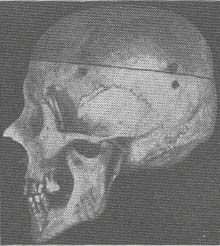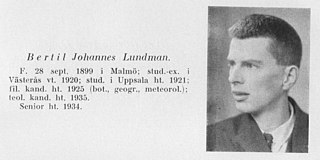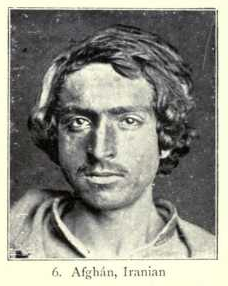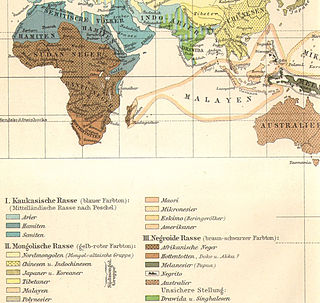Related Research Articles

The master race is a pseudoscientific concept in Nazi ideology in which the putative "Aryan race" is deemed the pinnacle of human racial hierarchy. Members were referred to as "Herrenmenschen".

The Dinaric race, also known as the Adriatic race, were terms used by certain physical anthropologists in the early to mid-20th century to describe the perceived predominant phenotype of the contemporary ethnic groups of southeast Europe.
The Caucasian race is an obsolete racial classification of humans based on a now-disproven theory of biological race. The Caucasian race was historically regarded as a biological taxon which, depending on which of the historical race classifications was being used, usually included ancient and modern populations from all or parts of Europe, Western Asia, Central Asia, South Asia, North Africa, and the Horn of Africa.

Aryanism is an ideology of racial supremacy which views the supposed Aryan race as a distinct and superior racial group which is entitled to rule the rest of humanity. Initially promoted by racist theorists such as Arthur de Gobineau and Houston Stewart Chamberlain, Aryanism reached its peak of influence in Nazi Germany. In the 1930s and 40s, the regime applied the ideology with full force, sparking World War II with the 1939 invasion of Poland in pursuit of Lebensraum, or living space, for the Aryan people. The racial policies which were implemented by the Nazis during the 1930s came to a head during their conquest of Europe and the Soviet Union, culminating in the industrial mass murder of six million Jews and eleven million other victims in what is now known as the Holocaust.

Joseph Yegorovich Deniker was a Russian Empire and French naturalist and anthropologist, known primarily for his attempts to develop highly detailed maps of race in Europe.
The Nordic race is an obsolete racial concept which originated in 19th-century anthropology. It was once considered a race or one of the putative sub-races into which some late-19th to mid-20th century anthropologists divided the Caucasian race, claiming that its ancestral homelands were Northwestern and Northern Europe, particularly to populations such as Anglo-Saxons, Germanic peoples, Balts, Baltic Finns, Northern French, and certain Celts and Slavs. The supposed physical traits of the Nordics included light eyes, light skin, tall stature, and dolichocephalic skull; their psychological traits were deemed to be truthfulness, equitability, a competitive spirit, naivete, reservedness, and individualism. In the early 20th century, the belief that the Nordic race constituted the superior branch of the Caucasian race gave rise to the ideology of Nordicism.
The Mediterranean race is an obsolete racial classification of humans based on a now-disproven theory of biological race. According to writers of the late 19th to mid-20th centuries it was a sub-race of the Caucasian race. According to various definitions, it was said to be prevalent in the Mediterranean Basin and areas near the Mediterranean, especially in Southern Europe, North Africa, most of West Asia, the Middle East or Near East; western Central Asia, parts of South Asia, and parts of the Horn of Africa. To a lesser extent, certain populations of people in Ireland, western parts of Great Britain, and Southern Germany, despite living far from the Mediterranean, were thought to have some minority Mediterranean elements in their population, such as Bavaria, Wales, and Cornwall.
Nordicism is an ideology which views the historical race concept of the "Nordic race" as an endangered and superior racial group. Some notable and influential Nordicist works include Madison Grant's book The Passing of the Great Race (1916); Arthur de Gobineau's An Essay on the Inequality of the Human Races (1853); the various writings of Lothrop Stoddard; Houston Stewart Chamberlain's The Foundations of the Nineteenth Century (1899); and, to a lesser extent, William Z. Ripley’s The Races of Europe (1899). The ideology became popular in the late-19th and 20th centuries in Germanic-speaking Europe, Northwestern Europe, Central Europe, and Northern Europe, as well as in North America and Australia.

The Alpine race is a historical race concept defined by some late 19th-century and early 20th-century anthropologists as one of the sub-races of the Caucasian race. The origin of the Alpine race was variously identified. Ripley argued that it migrated from Central Asia during the Neolithic Revolution, splitting the Nordic and Mediterranean populations. It was also identified as descending from the Celts residing in Central Europe in Neolithic times. The Alpine race is supposedly distinguished by its moderate stature, neotenous features, and cranial measurements, such as high cephalic index.
The Armenoid race was a supposed sub-race in the context of a now-outdated model of dividing humanity into different races which was developed originally by Europeans in support of colonialism. The Armenoid race was variously described as a "sub-race" of the "Aryan race" or the "Caucasian race".
The Nazi Party of Germany adopted and developed several pseudoscientific racial classifications as part of its ideology (Nazism) in order to justify the genocide of groups of people which it deemed racially inferior. The Nazis considered the putative "Aryan race" a superior "master race", and they considered Jews, black people, mixed-race people, Slavs, Roma, Africans and certain other ethnicities racially inferior "sub-humans", whose members were only suitable for slave labor and extermination. These beliefs stemmed from a mixture of historical race concepts, 19th-century anthropology, scientific racism, and anti-Semitism, especially racial anti-Semitism. The term "Aryan" generally originated during the discourses about the use of the term Volk.

Hans Friedrich Karl Günther was a German writer, an advocate of scientific racism and a eugenicist in the Weimar Republic and the Third Reich. He was also known as "Rassengünther" or "Rassenpapst". He is considered to have been a major influence on Nazi racialist thought.
William Zebina Ripley was an American economist, lecturer at Columbia University, professor of economics at MIT, professor of political economy at Harvard University, and racial anthropologist. Ripley was famous for his criticisms of American railroad economics and American business practices in the 1920s and 1930s, and later for his tripartite racial theory of Europe. His work of racial anthropology was later taken up by racial physical anthropologists, eugenicists, white supremacists, Nordicists, and racists in general, and it was considered a valid academic work at the time, although today it is considered to be a prime example of scientific racism and pseudoscience.

The Passing of the Great Race: Or, The Racial Basis of European History is a 1916 racist and pseudoscientific book by American lawyer, anthropologist, and proponent of eugenics Madison Grant (1865–1937). Grant expounds a theory of Nordic superiority, claiming that the "Nordic race" is inherently superior to other human "races". The theory and the book were praised by Adolf Hitler and other Nazis.

Bertil J. Lundman was a Swedish anthropologist.
Various attempts have been made, under the British Raj and since, to classify the population of India according to a racial typology. After independence, in pursuance of the government's policy to discourage distinctions between communities based on race, the 1951 Census of India did away with racial classifications. Today, the national Census of independent India does not recognise any racial groups in India.

The Irano-Afghan race or Iranid race is an obsolete racial classification of human beings based on a now-disproven theory of biological race. Some anthropologists of the 20th century classified the populations native to the Iranian plateau as belonging to this race, which was usually seen as a subrace of the Caucasian race or the Mediterranean racial subtype of that race, depending on the authority consulted.

Hamites is the name formerly used for some Northern and Horn of Africa peoples in the context of a now-outdated model of dividing humanity into different races; this was developed originally by Europeans in support of colonialism and slavery. The term was originally borrowed from the Book of Genesis, in which it refers to the descendants of Ham, son of Noah.

The Races of Europe: A Sociological Study is a 1899 book published by American economist, lecturer, and racial anthropologist William Z. Ripley. The book grew out of a series of lectures he gave at the Lowell Institute at Columbia in 1896. Ripley believed that race was critical to understanding human history, though his work afforded environmental and non-biological factors, such as traditions, a strong weight as well. He believed, as he wrote in the introduction to The Races of Europe, that:

Albinism is the congenital absence of melanin in an animal or plant resulting in white hair, feathers, scales and skin and reddish pink or blue eyes. Individuals with the condition are referred to as albinos.
References
- ↑ Race and Racism: An Introduction (see also) by Carolyn Fluehr-Lobban, Pages 127-133, Publication Date: December 8, 2005, ISBN 0759107955
- ↑ The Races of Europe by Carleton S. Coon
- ↑ Lundman, 1943, p. 134; 1977, p. 33.
- ↑ Eickstedt, 1935; Lundman, 1946, p. 17.
- ↑ Lundman, 1977, p. 33.
- ↑ Deniker, 1900, p. 328; 343.